Last Updated: October 31, 2012
NIKON FIELD ISO TEST

TEST PURPOSE
The purpose of the ISO test was to interpret the differences between the Nikon D800, D600 and D4. This new generation of FX full frame cameras provide improved dynamic range and great signal to noise capability. Additionally the D700 was also used in this testing to compare the newer cameras to the prior generation from Nikon.
The results were similar to what we anticipated. However, we found that each camera excels uniquely in different areas.
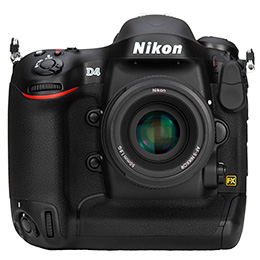 |  |  |
NIKON ISO FIELD TEST - D600 D800 D4 D700
ISO TEST SETUP
The test setup was fairly straight forward. All cameras were tested on the same lens using a tripod: Nikon 70-200mm f/2.8G VR-II at f/8 with autofocus and VR turned off. The tests were shot using the same white-balance settings and evaluated in RAW. RAW format was used primarily to prevent advantages in improved noise reduction techniques not present on the D700.
All cameras were used in manual mode to set exposure, and were identically set for each ISO shot.
ISO TEST RESULTS
Simply put, the results show that the Nikon D800E excels in the lower ISO range and outperforms all cameras below ISO 400. The D600 did not trail too far behind. However, at higher ISO sensitivities, the D4 really excelled more in dynamic range than the others. The D800E and D600 were not too far behind. The D700 trailed beyond those, with minimal detail, dynamic range, and much color noise.
When resizing the images down to 7MP, the SNR or image noise performance improves. At ISO 3200, the D800E had the best noise performance at this ISO when all images were compared at 7MP. However, at ISO 25600, the D4, regardless of how you resize it, noticeably outperformed all others. The results of this resizing are shown further down.
HIGH ISO COMPARISONS
ISO 3200
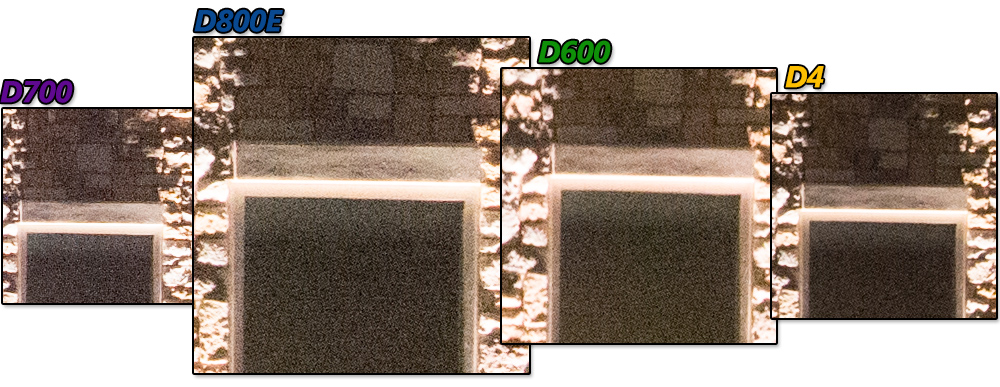
At ISO 3200, all the cameras looked decent. The Nikon D4 had the best dynamic range. The Nikon D800E had the best detail captured. Color noise starts to creep in on the D700, and dynamic range suffers more than on the other cameras.
ISO 6400
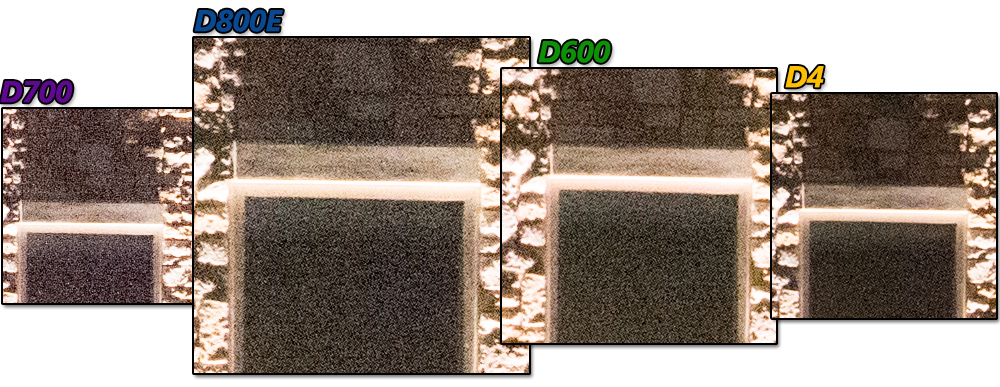
At ISO 6400, the D4 continues to outperform the others in dynamic range and noise. The D600 is now starting to show similar capability to the D800, as the D800s detail is suffering due to the magnitude of noise present. The D700 begins to diminish from this point forward.
ISO 12800
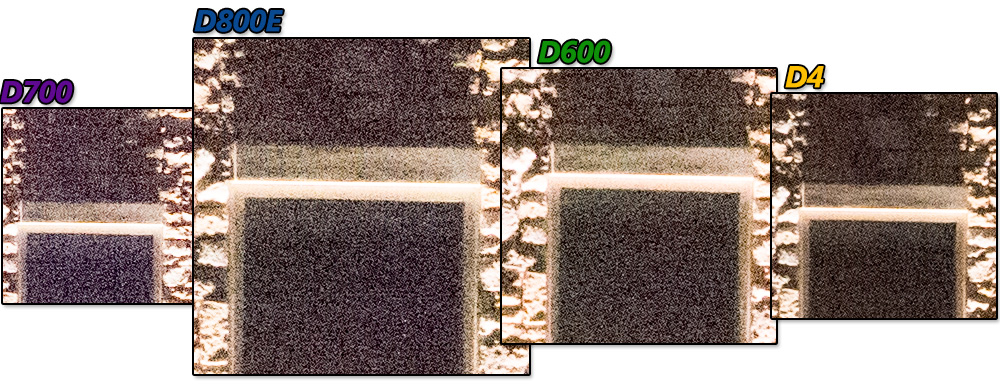
At ISO 12800, the D4 holds on nicely to its dynamic range. The D600 is probably second best here, followed by the D800E and then the D700. The D700 becomes almost unusable here. The D800E is also not able to capture any more detail than the D600 here, regardless of the number of megapixels.
ISO 25600

At ISO 25600, the D4 really separates itself from the crowd. Although everything has become really noisy, the D4 is still able to capture detail and retain a reasonable dynamic range.
RESIZED ISO COMPARISONS
Resizing images down to a smaller size can be advantageous to image quality. This advantage comes from under sampling data. When data undergoes decimation, a low pass filter is inherently performed. This may be commonly referred to an anti-aliasing filter. What it does is remove high frequencies to prevent digital aliasing artifacts back into the image.
For cameras with dense sensors, such as the D800E, this works as a huge benefit. Because of its large 36MP resolution, the high frequency noise data is removed by the under sampling anti-aliasing filter, thus enhancing the image quality. The resize data is shown below.
ISO 3200 - RESIZED 7MP
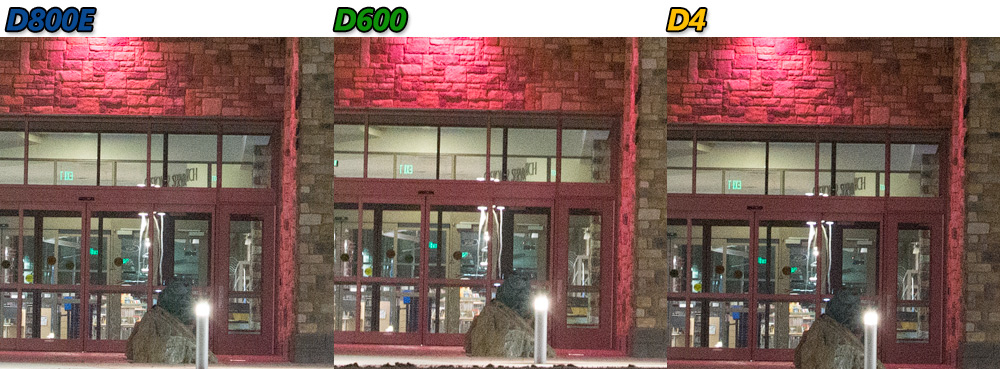
One last thing to note here, is that despite the improved noise performance of the D800, the dynamic range and color depth is still slightly better in the D4. You can see this slightly. Look at the light pole and exit reflection sign.
ISO 25600 - RESIZED 7MP

However, at higher ISOs where dynamic range is not as well retained, the D800 does not get the same advantage as it did at ISO 3200. This is where the D4 still has more capability. The D600 performs slightly better than the D800 in this range.
| SNR MEASUREMENTS (dB) | ||||
| Camera | ISO 3200 | 3200 (7MP) | ISO 25600 | 25600 (7MP) |
| Nikon D4 | 27.31 dB | 32.14 dB | 20.01 dB | 24.12 dB |
| Nikon D800E | 24.26 dB | 32.60 dB | 16.03 dB | 21.86 dB |
| Nikon D600 | 25.18 dB | 31.98 dB | 16.84 dB | 21.97 dB |
| Nikon D700 | 23.40 dB | 27.95 dB | 14.83 dB | 18.09 dB |
CONCLUSION
WHICH IS BETTER?
Overall there is not anything unsurprising to conclude. The D4's sensor is tuned more for high ISOs than it is for the lower ISOs. The D800E has the best image quality closer to the base ISO 100. The D600 performs well across the board. The D700 shows its age, and struggles to keep up with this new generation of cameras. This is not to say that the D700 is less than capable. It is among the most popular FX cameras currently and has had an excellent reputation throughout its product life-cycle.
What are some of your conclusions, from experience or through visual inspection?